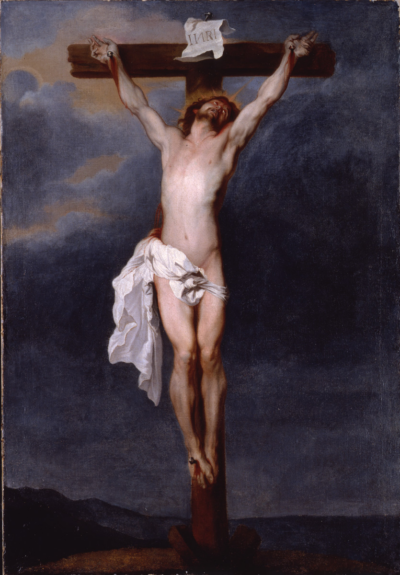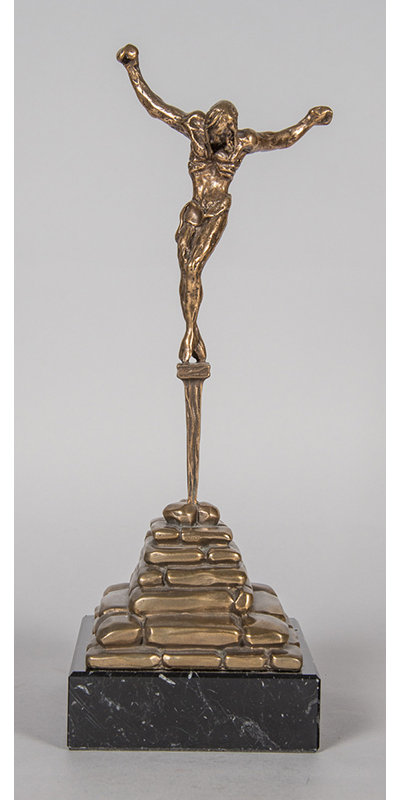La Salle University
Fourth Week of Lent Reflection
Looking at the art:

The Crucifixion
17th Century
53 7/8 x 37 1/8 in. (136.8 x 94.3 cm)
Studio of Anthony van Dyck, Flemish, (1599–1641)
Object Type: PAINTINGS
Creation Place: Europe
Medium and Support: Oil on canvas
Credit Line: Purchased with funds provided by Father Thomas Loughren and the Art Angels
Accession Number: 98-P-452
Current Location: Art Museum : 17 C Gallery

Christ of St. John of the Cross (Crucifixion)
1974
177 x 5 1/8 x 5 1/8 in. (449.6 x 13 x 13 cm)
Salvador Dali, Spanish, (1904–1989)
Object Type: SCULPTURE
Creation Place: Europe, Spain
Medium and Support: Bronze, marble base
Credit Line: Gift of Joseph. S. Czestochowski
Accession Number:00-SC-51
Current Location: Art Museum : 20 C Gallery
Matthew’s gospel tells that darkness came over the land from noon to three in the afternoon on the day Jesus was crucified. Van Dyck’s Flemish assistant privileges this dark turbulent sky as the background and stark contrast to the highlighted body of Jesus dying on the cross. As such, there is nothing to distract the eye from Jesus’s body, hanging limp on the cross. Light is focused straight from the space of the viewer onto the body of Jesus, his loin cloth, and the sign marking him as King of the Jews. This is consistent with Baroque predilection for chiaroscuro, that subtle interplay of dark and light that trains the eye on an object or person to elicit a personal emotional response. Here the response is an engagement with the dying Jesus.
Dalí’s sculpture in bronze of Jesus hanging is unique in that there is no cross. The point of reference is Dalí’s famous painting of the same name in which there is indeed a cross but no nails, no crown of thorns and no blood to taint the portrayal of the dying Christ. Both depictions are said to have been inspired by a drawing made by the sixteenth-century Spanish mystic John of the Cross. Our sculpture lays bare the body alone on its base in a hanging position and leaves it to the viewer to reconstruct the cross in the mind. This is consistent with the Surrealist’s eye which blurs the boundaries between the conscious and the subconscious mind. Dalí himself described it as a “spontaneous method of irrational knowledge” which allowed him to tap into the subconscious and explore the depths of his own psyche. Supplying an image of the cross here in the mind thus enables a viewer to reflect on metaphorical crosses that are deeply personal and sometimes beyond the understanding of the conscious mind.
Reflection
Stat crux dum volvitur orbis. This is Latin for “The Cross is steady while the world turns.” It is the motto of the Carthusians. As a young aspirant, many years ago, I came across this saying, translated a little differently, “Stands the cross, still point of the turning world” during one of our summer retreats. It struck me then and still strikes me as a bold statement. Here is the center of the entire world as we know it. This single act of cruelty and immense pain is what all of history leads up to and from which all of history will unfold. Maybe if you had told me that the Resurrection was the still point it would have made sense, but this death is hard to understand. I admit that looking at these two pieces of art I am again struck by the audacity of the statement.
The image appeals to me for many reasons. The cross is not steady because it stands against the world but because it is for the world, the anchor that gives meaning to all the suffering that has been, is and will be.
The cross is the definitive and irreversible ‘no’ of God to violence, injustice, hate, lies – to all that we call ‘evil,’ and at the same it is equally the irreversible ‘yes’ to love, truth and goodness.
No one should ever give up hope because the cross is the living proclamation that the final victory does not belong to the one who triumphs over others but to the one who triumphs over self; not to the one who causes suffering but to the one who is suffering.
For some reason, these two images, the cross alone, no other figure, nothing to take my gaze away from the suffering one, speak to me powerfully of these truths. The cross is the pivot around which all of history, my life, all our lives move and have any kind of meaning.
This Lent I struggle with that. What position does the cross have in my life? Do I understand it as the center point of my life? Am I willing to let the cross be the center of my life?